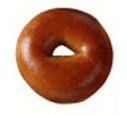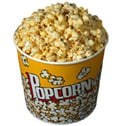About The Buzz: Portion Distortion Contributes to Overweightness and Obesity?
WHAT THEY’RE SAYING
Portion sizes in the American diet have changed dramatically in the past 20 years, steadily growing larger and larger with time.
WHAT THIS MEANS
Larger portion sizes have contributed to the current rate of overweightness and obesity in American children and adults. At this point in time, 68.6% of U.S. adults are overweight or obese.1 There are many, many factors that influence how much a person weighs, including diet, level of physical activity, socioeconomic status, level of education and geographic location. In addition, stress, sleep (or lack thereof), and schedule can also contribute to weight gain.
In order to achieve and maintain a healthy weight, portion sizes should reflect an individual’s caloric needs. Each person’s body has varying energy needs, based on weight, height, sex and typical physical activity levels. For example, a small female child needs far fewer calories than a 22-year-old male college athlete. Regardless of caloric needs, however, portion sizes have continued to increase in the United States, meaning that Americans are consuming more food than is necessary for health and well-being. Below are a few popular food items that have dramatically increased in size and caloric density in recent years.2
How Portion Sizes Have Increased in Recent Years
Serving Size
Bagel
20 years ago: 3-inch diameter
Today: 6-inch diameter20 years ago: 140 calories

Today: 350 calories

20 years ago: 333 calories Today: 590 calories
Cheeseburger

20 years ago: 210 calories Today: 610 calories
French Fries
20 years ago: 2.4 ounces
Today: 6.9 ounces

20 years ago: 45 calories Today: 350 calories (with steamed milk and mocha syrup)
Coffee
20 years ago: 8 ounces
Today: 16 ounces

20 years ago: 210 calories Today: 500 calories
Muffin
20 years ago: 1.5 ounces
Today: 4 ounces

20 years ago: 270 Today: 630
Movie Theater Popcorn
20 years ago: 5 cups
Today: 11 cups

WHY THIS MATTERS
Consuming more calories than needed will inevitably cause you to gain weight. In order to maintain a healthy weight, the calories “in” must equal the calories “out.” In other words, a person must consume as many calories each day as they’re using. Calories are consumed through foods and beverages and the body uses them to fuel all of your daily activities – from walking to your car, to folding your laundry to working on a report at work. Any movement you make causes your body to use energy. Some activities are much more physically demanding and require much greater energy expenditure. Examples of physical activity include jogging, walking to work, playing golf, swimming, riding a bike, or gardening.
In order to maintain or achieve a healthy weight and reap other substantial health benefits, adults should do at least 150 minutes (2 hours and 30 minutes) a week of moderate-intensity, or 75 minutes (1 hour and 15 minutes) a week of vigorous-intensity aerobic physical activity, or an equivalent combination of moderate- and vigorous-intensity aerobic activity.3 Aerobic activity should be performed in episodes of at least 10 minutes, and preferably, it should be spread throughout the week. Children and adolescents should do 60 minutes (1 hour) or more of physical activity daily.3
OUR ADVICE
In this day and age, when portion sizes have increased so dramatically, it can be challenging to know how much to eat of any given food. Even if you’re regularly engaging in physical activity throughout the week, eating too many calories will result in weight gain. How can a person know how much food to eat? We have some recommendations for you!
- First and foremost, fill half your plate with fruits and veggies for every meal and snack. Vegetables and fruits are packed with vitamins and minerals, nutrients, antioxidants and fiber. They’re also very low in calories. The combination of high nutritional density and low calories makes them very nutritious choice.
- Avoid foods heavy with sauces, creams, marinades or spreads. These items are generally very high in calories and offer little or no nutritional benefits. Instead, flavor foods with spices, herbs and other seasonings.
- Prepare meals at home. Any time you can, prepare food yourself at home. While this option may seem time consuming, preparing meals yourself allows you to know exactly what is in your foods and how many of each and every ingredient being used. Preparing your own meals also allows you to choose your own portion size (which will likely be considerably smaller than a portion size you’d receive at a restaurant).
- Check the labels (or menu). Most restaurants now publicly display caloric information on their display menu at the checkout, on table menus or on their website. This information can help you navigate your options when going out to eat. If you’re going out for dinner and don’t want to overeat, aim for an option that is lower in calories. This might mean choosing a salad and soup and lemon water with a total of 600 calories rather than a cheeseburger with cheesy bacon French fries and a soda for 1,400 calories.
- Be smart with beverages! Water is completely free of calories and hydrates your body without any added flavors, sugars or chemicals. Sugar-sweetened beverages, such as sports drinks and sodas, are filled with sugar and do not offer any nutritional benefits whatsoever. On the other hand, 100% juice offers virtually the same nutrition as whole fruit. Up to half of your fruit can be consumed as juice; which is about 6-12 ounces each day depending on your calorie needs.
Video Center: Selection. Storage. Preparation.
How Many Cups Do You Need?
Key Nutrients in Fruits & Vegetables
Fruit & Veggie Database


